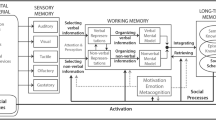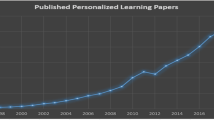Abstract
Mobile technologies are increasingly being promoted as tools to enhance learning. They can be used to augment ongoing activities, such as exploring outdoors, by enabling users to move back and forth between the physical environment and a variety of digital resources and representations. In so doing, they have the potential to facilitate sensemaking activities, where people seek to find structure in an uncertain situation through using a combination of information, communication and computation. However, continuous switching of attention between different representations and activities can be distracting. Our research is concerned with how mobile devices can be used to engender collaborative sensemaking activities during scientific tasks. We present two studies showing how different versions of a mobile learning application, LillyPad, were used by teams to make sense of their ongoing observations, when measuring the effects of different planting methods for an environmental restoration site. The findings show marked differences in the amount and type of sensemaking. We discuss reasons for this in terms of task demands and workload, information type and distribution of devices.





Similar content being viewed by others
References
Roschelle J, Pea R (2002) A walk on the wild side: how wireless handhelds may change CSCL. In: Proceedings of CSCL 2002. Lawrence Erlbaum Associates, Mahwah, NJ, pp 51–60
Russell D, Jeffries R, Irani L (2008) Sensemaking for the rest of us. In: CHI’08 workshop proceedings. Available via ACM digital library http://dmrussell.googlepages.com/sensemakingworkshoppapers. Accessed 9 Aug 2008
Klein G, Moon B, Hoffman RF (2006) Making sense of sensemaking I: alternative perspectives. IEEE Intell Syst 21(4):70–73
Schoenfeld AH (1992) Learning to think mathematically: problem solving, metacognition, and sensemaking in mathematics. In: Grouws D (ed) Handbook for research on mathematics teaching and learning. MacMillan, New York, pp 334–370
Gordon DN, Edelson DC, Pea RD (1996) Supporting students’ science inquiry through scientific visualization activities. Presented as part of “Scientific Visualization Tools in Science Classrooms” at the annual meeting of the American Educational Research Association, New York
Newman D, Torzs F (1991) A world in the classroom making sense of seasonal change through talk and technology. Center for Technology in Education, Technical report no. 11
Chi M (1997) Why is self explaining an effective domain for general learning activity? In Glasser R (ed) Advances in instructional psychology. Lawrence Erlbaum Associates, Mahwah
Loh B, Radinsky J, Gomez L et al (2001) Developing reflective inquiry practices: a case study of software, the teacher and students. In: Crowley SK, Chunn CS, Okada T (eds) Designing for science: implications from everyday, classroom, and professional settings. Lawrence Erlbaum Associates, Mahwah, NJ
Chan TW, Roschelle J, Hsi S et al (2006) One-to-one technology-enhanced learning: an opportunity for global research collaboration. Res Pract Technol Enhanc Learn 1(1):3–29
Laws P (1997) Millikan lecture 1996: promoting active learning based on physics education re-search in introductory courses. Am J Phys 65(1):13–21
Layman JW, Krajcik JS (1990) The use of microcomputer-based laboratories in constructing science concepts. Presentation at the National Science Teachers Association, Area Convention, Washington, DC, 13–15 December
Gay R, Rieger R, Bennington T (2002) Using mobile computing to enhance field study. In: Miyake N, Hall R, Koschmann T (eds) CSCL 2: carrying forward the conversation. Lawrence Erlbaum Associates, Mahwah, NJ, pp 507–528
Grant WC (1993) Wireless coyote: a computer-supported field trip. Commun ACM 36(2):57–59
Hine M, Rentoul R, Specht M (2004) Collaboration and roles in remote field trips. In: Attewell J, Savill-Smith C (eds) Learning with mobile devices: research and development. Learning and Skills Development Agency, London, UK
Rogers Y, Price S, Randell C et al (2005) Ubi-learning: integrating outdoor and indoor learning experiences. Commun ACM 48(1):55–59
Sharples M, Corlett D, Westmancott O (2002) The design and implementation of a mobile learning environment. Pers Ubiquit Comput 6:220–234
Soloway E, Norris C, Blumenfeld P et al (2001) Log on education: handheld devices are ready-at-hand. Commun ACM 44(6):15–20
Soloway E, Norris C, Blumenfeld P et al (1996) Learning theory in practice: case studies of learner-centre design. In: Proceedings of CHI. ACM Press, New York, pp 189–196
Yeh R, Liao C, Klemmer S et al (2006) ButterflyNet: a mobile capture and access system for field biology research. In: Proceedings of CHI’06. ACM Press, New York, NY, pp 571–580
Järvelä S, Laru J, Näykki P (2007) How people collaborate to learn in different contexts scaffolded by the mobile tools. In: Arnedillo-Sánchez I, Sharples M, Vavoula G (eds) Proceedings of beyond mobile learning workshop
Rost M, Holmquist LE (2008) Tools for students doing mobile fieldwork. In: Proceedings of WMUTE’08. IEE, Computer Society, pp 74–81
Spigol D, Milrad M (2008) Combining physical activities and mobile games to promote novel learning practices. In: Proceedings of WMUTE’08. IEE, Computer Society, pp 31–38
Hsi S (2002) The electronic guidebook: a study of user experiences using mobile web content in a museum setting. Paper presented at the International Workshop on Wireless and Mobile Technologies in Education, Växjö, Sweden
Semper R, Spasojevic M (2002) The electronic guidebook: using portable devices and a wireless web-based network to extend the museum experience. In: Proceedings of museums and the web, Boston, MA, March 2002
Price S, Rogers Y, Stanton D, Smith H (2003). A new conceptual framework for cscl: supporting diverse forms of reflection through multiple interactions. In: Wasson B, Ludvigsen S, Hoppe U (eds) Designing for change in networked learning environments. Proceedings of the international conference on computer supported collaborative learning 2003, pp 513–522
Rogers Y, Connelly K, Tedesco L et al (2007) Why it’s worth the hassle: the value of in situ studies when designing UbiComp. In: Krumm J et al (eds) UbiComp 2007, LNCS 4717. Springer, Berlin, pp 336–353
Sugimoto M, Hosoi K, Hashizume H (2004) Caretta: a system for supporting face-to-face collaboration by integrating personal and shared spaces. In: Proceedings of CHI’2004. ACM Press, New York, pp 41–48
Acknowledgments
We thank the Eli Lilly and Company Foundation, the Rotary Club of Indianapolis and the Pervasive Technology Labs, Indiana University for funding the project. We are indebted to Andrew J. Kurtz and Josh Hursey for programming and helping with the design of the application. Thanks also to Bob E. Hall, Kara Salazar and Polly Baker at IUPUI, Tammy Toscos, Allen Lee, CJ Fleck, Nick Gentille and Anne Stephenson at IUB and Paul Marshall at the OU for their various contributions. Finally, we thank all the team leaders, students and volunteers who participated in the measuring days.
Author information
Authors and Affiliations
Corresponding author
Rights and permissions
About this article
Cite this article
Rogers, Y., Connelly, K., Hazlewood, W. et al. Enhancing learning: a study of how mobile devices can facilitate sensemaking. Pers Ubiquit Comput 14, 111–124 (2010). https://doi.org/10.1007/s00779-009-0250-7
Received:
Accepted:
Published:
Issue Date:
DOI: https://doi.org/10.1007/s00779-009-0250-7




